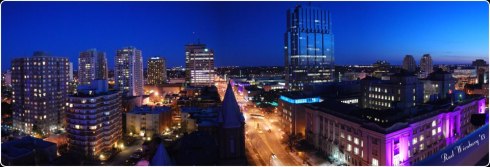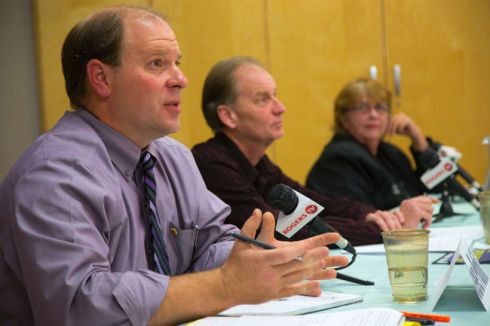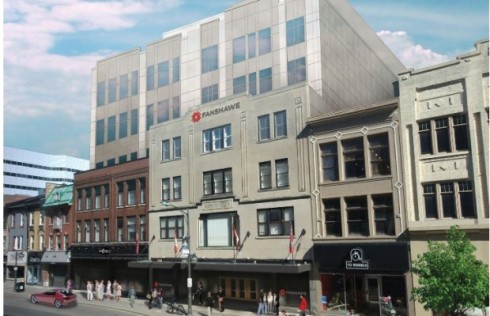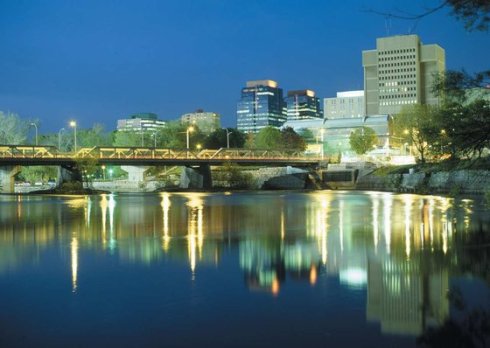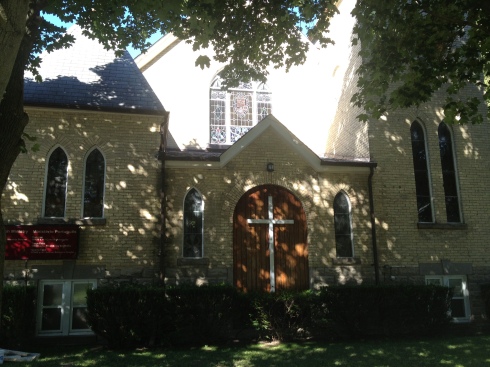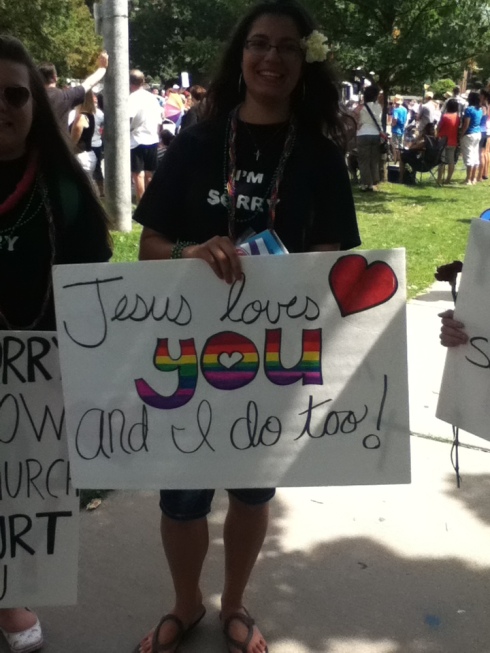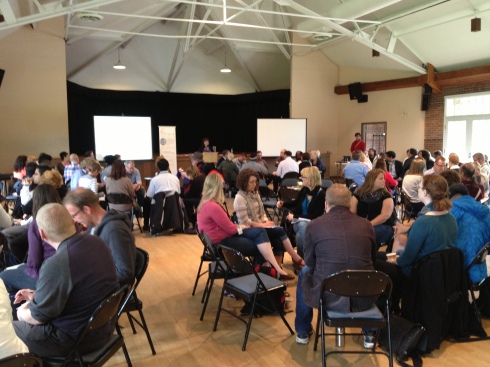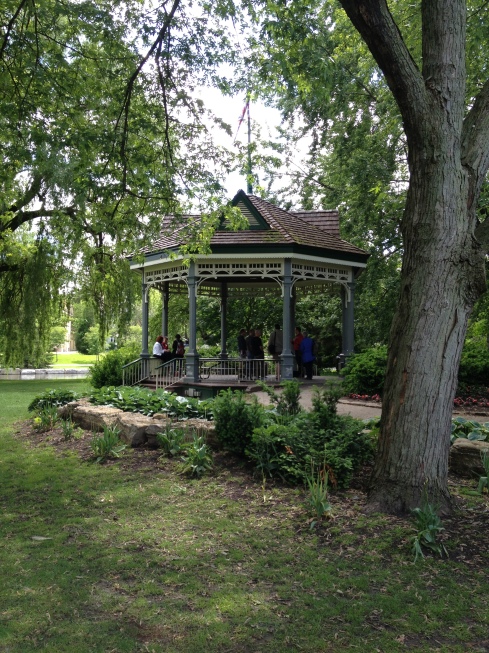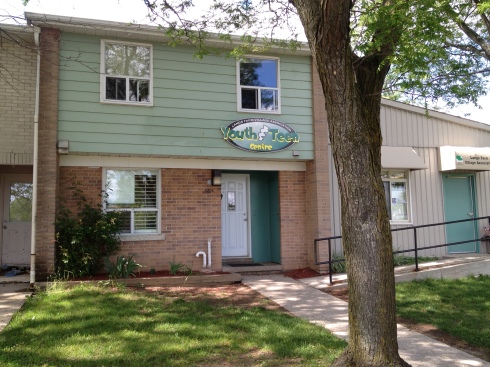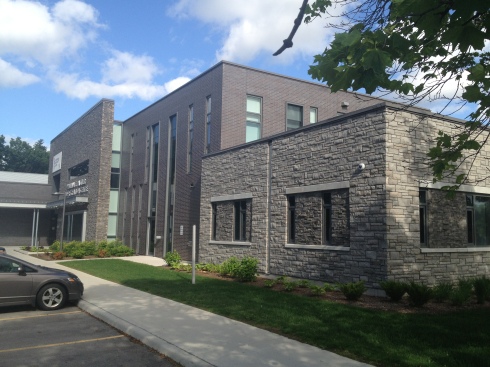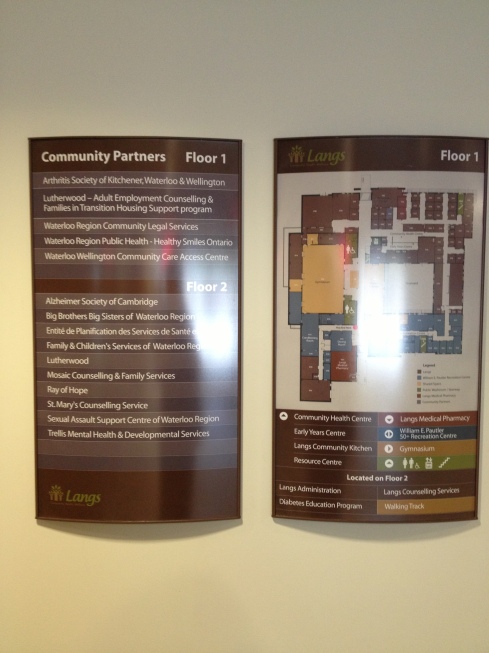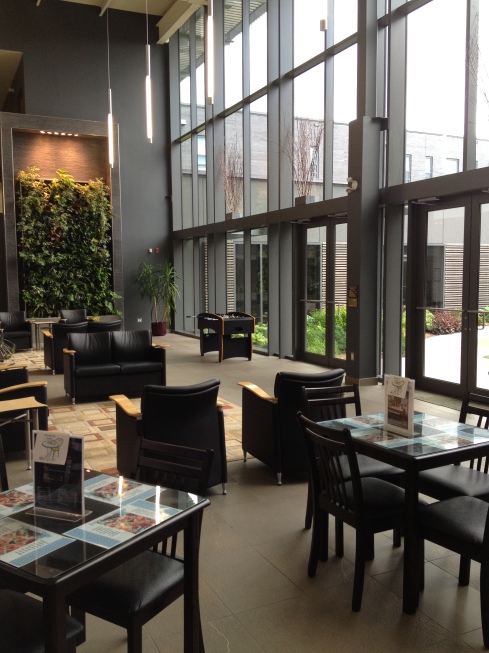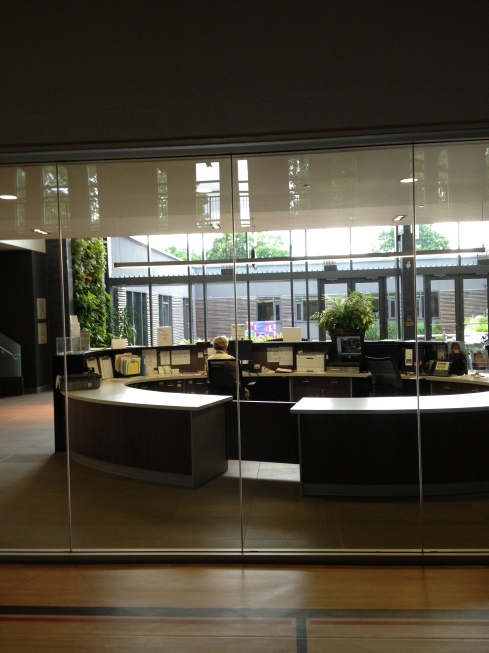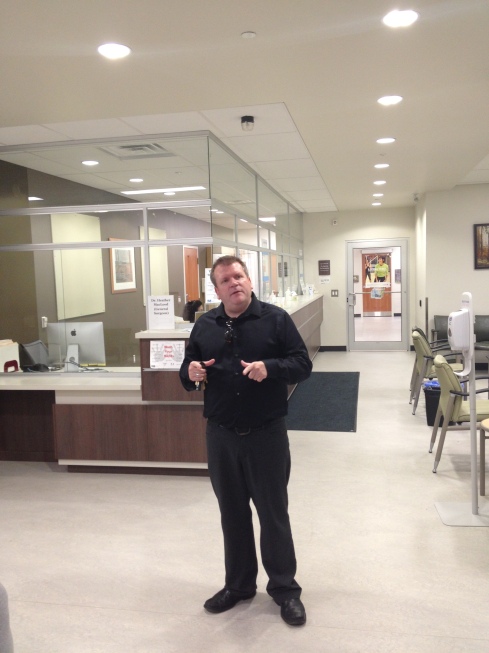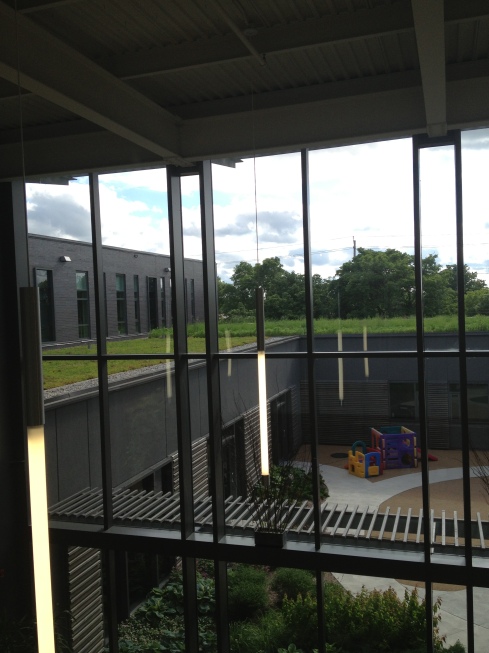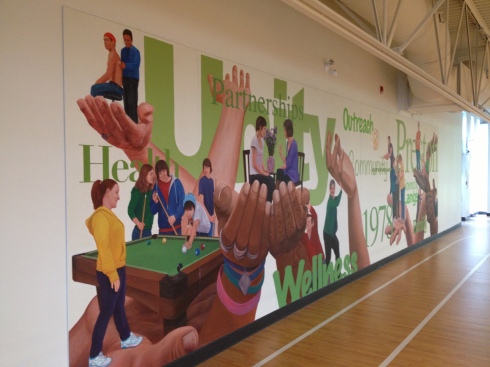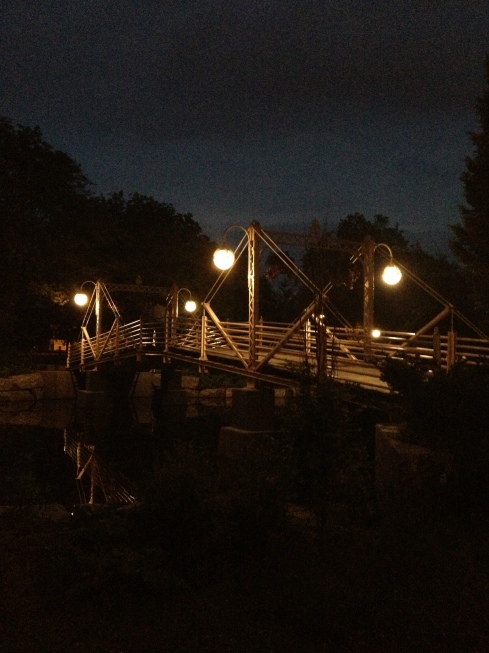You are currently browsing the tag archive for the ‘Community’ tag.
Election Day is finally here!
Today finds us in a very different place than November 2010. Mayor Fontana stepped down before completing his first term after being convicted of fraud. Councillor Joni Baechler is now Mayor Baechler after being appointed to the position until the election. Several wards are without an incumbent, with councillors not seeking re-election, and Councillors Swan and Brown vying for the mayor’s chair. On top of that, we’ve had upsets in the mayoral race as Roger Caranci stepped down from the campaign, after the advanced polls had opened, to endorse his once-rival Paul Cheng, a complete unknown who is polling close behind front-runner Matt Brown.
So – a lot of potential for big changes on council! I’m hoping that this election will help renew interest in the electoral and civic process, and I plan to continue blogging and closely following the next council session.
But most importantly – make sure to get out there today and VOTE!!!
If you aren’t sure about any part of the election, there is still time to get acquainted with where to go and who your candidates are:
Not sure which ward you are in? Check out this map on the City’s website.
Not sure who your candidates are? The City’s website lists all candidates here.
Looking for where to vote? The City website will show you where to go.
Looking for more coverage of the campaigns? My friend Thomas Thayer (@talkw3rds) has written excellent posts on the campaigns in his blog.
Looking for an election night event? Check out Election Night at the Convention Centre!
To finish this post, I’ll leave you with this poem “Your Voice, Your Vote” by the amazing Holly Painter (@Hey_MissP), check it out!
Next post: London Votes 2014 Recap
Previous post: Cheng’s Campaign of Contradictions
I believe Nancy McSloy would be the best representative for our ward. Not only are her views on the ward and our city progressive and closest to mine, but I’ve had the opportunity to get to know her as a person before the election. I was able to volunteer with her on the Strengthening Argyle Neighbourhood Task Force and the Argyle Community Association, and have witnessed her passion for the our ward and the city firsthand. The London and District Labour Board removed their endorsement of Bill Armstrong (more on that below) and endorsed her campaign, saying she would be a progressive voice on Council. As her About page shows, she has volunteered and worked in on a number of fronts, and I’ve been very impressed by what I have seen. In volunteering with McSloy at Argyle local events I’ve been amazed by the amount of community members who know and deeply respect Nancy. Her heart is here, and the community seems to know it. It’s not a far jump from knowing a community well to representing a community well, and shifting from being a researched, dedicated and communicative volunteer to a councillor.
I also believe that her two opponents are not the best representatives for our city.
Bill Armstrong has been known as a progressive candidate but over the past council term has been slipping towards the “Fontana 8” on key votes, including the Reservoir Hill and PenEquity developments. This trend seemed to accelerate once Fontana stepped down from office and Councillor Swan became the heir-apparent of the group, including Armstrong voting against the Fanshawe-Kingsmills deal. This is despite the fact that it would help the school expand operations in ward 3 and likely bring more student activity to ward 2. This didn’t miss the notice of the London and District Labour Council – he lost their endorsement to McSloy because of his voting pattern over the last term. Armstrong has reacted passionately about a few issues in the ward, like the sound barriers along Veterans and opposition to a home for autistic adults that’s scheduled to be built near us (only a few neighbours actually seem to be against this development). Generally his votes are unpredictable, and appear to be based on his personal opinions. Most of the people I have spoken to in the ward who have made efforts to communicate with Armstrong were met with silence. Armstrong seems to have coasted for twenty years on voter apathy and a lack of strong candidates who can beat the automatic boost from being incumbent. Last election he won with only a small margin over Steve Polhill.
On the conservative side is Steve Polhill. If the donations for Bud Polhill and Steve Polhill in the 2010 election are any indication, the apple doesn’t fall far from the tree. Bud Polhill was a staunch member of the Fontana 8 in the last Council term, and has been involved in both secret meeting controversies investigated by the Ontario Ombudsman. The last thing we need is a second Polhill at the Council table. He appears to have made his banner issue the proposed rec centre to be built in 2018 in East Lions Park, and how it should be relocated to another site like the former Churchill Public School site. This issue didn’t actually appear to be an issue to anyone until Polhill made it an issue (we live near the park, and everyone we’ve spoken to has been enthusiastic about the project and what it will mean for the East Lions neighbourhood), and I’ve seen very little else from his campaign to distinguish him as a candidate other than being a Polhill.
How will this ward race go? I think it is still anyone’s guess. 2010 saw a close race between Polhill and Armstrong, I believe down a conservative/progressive divide. Incumbency is hard to defeat, but Polhill has spent these last four years involved in the community, and the lines of progressive/conservative have been blurred. Nancy is a well-known and well-respected member of the Argyle community though and I think has really shook up what could have been a 2-candidate race. The London Free Press gives this assessment: “A horse race, with McSloy winning endorsement from the London and District Labour Council and a record of activism under her belt. Polhill has name recognition, from his politician father, and a pro-development stance.”
How has the campaign gone? These are Nancy’s thoughts on the campaign, in her own words:
The past eight months have been a whirlwind of being out in the community and knocking on doors. I have been through three seasons, spring, summer and now fall. I have also been through almost every kind of weather except for a blizzard.
Ward 2 is full of beautiful streets and neighbourhoods. I have seen so many beautiful front yards and gardens and now I am seeing many awesome Halloween displays. This shows the pride that the residents of the ward take in their homes and communities. I want to work hard for the great people of the ward for the next four years.
My team of volunteers has been amazing; we have walked hundreds of miles as we have been to every street at least once, some two or three times. I have had many people ask for signs for their lawn and many people who have donated to my campaign. For that I want to say thank you to each and every one for putting their support behind me.
Of course there have been some hiccups along the way, but I have been working throughout the community for many years and decided that no matter what I was going to keep going as I want to represent the people of Ward 2 at City Hall. I have made it to “Election Eve” and now it is a matter of waiting for the results. Tomorrow is going to be the longest day of the campaign, but to everyone who has been part of this journey I want to say thank you from the bottom of my heart.
08/16/2014 12:25pm UPDATE: I’ve added responses received from councillors to the bottom of this post.
I’ve been following with excitement the Fanshawe College proposal to renovate the historic Kingsmills building downtown into new classroom space for 1,600 students – as a Londoner and alumnus I’m glad to see the rapid expansion of the school. I watched the Fanshawe presentation to the London Advisory Committee on Heritage (LACH) with great interest (in the gallery with Molly, as Sarah is a member of the committee). The committee seemed equally impressed, and felt that the proposal, though extensively renovating and updating the building, took prudent steps to maintain the heritage of the site. A downtown heritage building that is no longer useful is at risk, and this proposal balanced preservation and occupation.
It is then with great disappointment that I watched Council vote down the proposed project and request for $10M investment by the city, despite the $66M being paid by Fanshawe to make this happen. I was especially surprised that one of the reasons cited by Joe Swan was concern about preserving the heritage of the building – why have advisory committees if their recommendations are ignored? Did he think LACH didn’t dig deep enough, or did he simply not read the report? Fanshawe’s pitch made it very clear that they would be undertaking hassle and expense to not just preserve but to restore the historic Dundas Street facade.
A lot of the issue has been chalked up to an election year – voters are scrutinizing how councillors spend their tax dollars, and with a city that elected Joe “0%” Fontana four years ago, many candidates are probably concerned with being perceived as big spenders. In particular, with Ward 3 Councillor Swan taking a run at the big seat, he is trying to channel a similar “friend of the taxpayer” persona.
However, this is foolhardy on two fronts.
First, this makes it seem that the money would have to be levied through higher taxes, when there is already money set aside for exactly this kind of project. The city has funds for investment and the economic prosperity of the city – surely investing in one of city’s largest institutions to purchase and reinvest in one of the historic downtown buildings is exactly the purpose of those funds? The only other project on the horizon that could be a contender is the hotly debated Performing Arts Centre, and there are assurances that should such a project go forward, there are ample funds for both projects.
Second, Swan of all councillors should be supporting this project, with the main Fanshawe College campus in his ward. Beyond the massive investment in the downtown core, it gives Fanshawe much-needing breathing room as their attendance continues to climb as they expand their course offerings, and they stretch the limits of the main property. Already they have expanded to a massive new building at Oxford & Third as well as the first phase of downtown development, across from the now-empty Kingsmills building. Investing in Fanshawe brings more students to the city and higher demand for jobs including faculty, and gives Fanshawe space to bring 1,600 new students to Swan’s ward. This is exactly the kind of innovative and progressive vision we need for our city, the kind of vision Swan is evidently lacking.
The last vote failed with a tie vote, with Henderson not there – he has indicated had he been there, he would have also voted against the proposal. Those that voted against it were Councillors Bud Polhill, Bill Armstrong, Joe Swan, Stephen Orser, Paul Van Meerbergen, Denise Brown and Sandy White.
Today, the London Downtown Business Association has called an emergency meeting to address what can be done, but there is only a faint hope – to reignite the debate at Council it would take 2/3 to vote for a renewed discussion, meaning several councillors would have to change their vote.
It may seem a slim chance, but if you think this project is what London needs, please take a few minutes to write to Council to express your views. This is the letter I’ve sent to Council, you’re welcome to use it as a template if it would help frame your thoughts on this important issue.
To London City Council,
I’m writing today to ask you to reopen the debate on the proposal by Fanshawe College for $10M towards their investment in the now-vacant Kingmills building downtown, and to support the proposal. Accepting this proposal would show excellent leadership and investment in our city by this Council. Fanshawe is putting forward $66M into this project, noting that they could much more easily build a new building on cheaper property, but they are choosing to move downtown and invest heavily in one of the historic storefronts, and teaching their culinary students while opening a new restaurant downtown. As well, LACH and senior city staff including Martin Hayward and John Fleming support this plan – as Councillor Branscombe has noted, whether to support this project seems to be a “no-brainer”. This project will pay massive dividends for our city, and be one of the shining moments of this Council session, should it go through.
In particular, I ask Councillors Armstrong and Swan to reconsider their position on this proposal, as this plan will greatly impact their wards. Fanshawe is already stretched to the limits of their existing property even as they are continuing to expand their attendance and course offerings, if this project were to go forward 1,600 students would be admitted to the downtown campus, opening space for 1,600 new students at the main campus. London desperately needs new, innovative minds, every effort should be made to bring more students to the city, and retain them after graduating. Investment downtown creates opportunities all over London.
With this proposal, Fanshawe College is showing vision, innovation and leadership. Today I ask that you stand with them, and do the same.
Thank you for your time and consideration, please contact me if you’d like to discuss this issue further.
Sincerely,
Brian Gibson
Ward 2
UPDATE: Below are the responses I’ve received from Councillors.
I received this response from Councillor Matt Brown 3:05pm August 15:
Thank you for taking the time to write this Brian. Best regards, Matt
Matt Brown
City Councillor, Ward 7
I received this response from Dawn MacLean on behalf of Councillor Russell Monteith 3:43pm August 15:
Good afternoon Brian,
On behalf of Councillor Russell Monteith, thank you for your email. Your comments and concerns have been noted and will be taken into consideration.
I received this response from Councillor Joe Swan 5:31pm August 15:
Dear Brian
Thank you for writing. I know you care about doing the right thing for London,
Here is some excerpts from my letter to the downtown business association in a genuine effort to keep the project moving forward:
I indicated to the Business association that it is my belief that all city council members seek a solution that is good for the entire community and is within the existing City of London budget allocation.
The city has committed $20 million to ensure the College locates in the downtown. The College has indicated up to 20 other properties in the downtown that may be available to make their campus a reality without the need for an additional $10 million of local taxpayer support. Those buildings may be a more economical solution, with the same or better economic impact.
I indicated this particular property (Kingsmills) was from a construction and facility cost point of view too expensive at $660 per square foot basis, (Fanshawe’s own consultant said the price was “exorbitant” school costs are usually about $350 per sq ft.). Also the location of the project meant the College would exceed the approved budget allocation of the City. The proposal will also demolish an important heritage property. The project does not have Provincial government financial support, yet it is a Provincial responsibility to fund Colleges. As Chair of the City Investment (IEPC) committee I have been made aware of at least two other private sector owners that have indicated they have viable alternatives that do not require additional city funds. I presume they have not contacted Fanshawe or the downtown association yet as the current plan appears to be an intractable position for the benefit of one property owner.
I met with the downtown business association in good faith to suggest how we all might be able to move forward with a plan for Fanshawe downtown. I believe the downtown business association has the mandate and the capacity to take a professional business minded approach to help overcome difficult issues in the interests of all stakeholders.
I laid out to the association what I believe is a positive process that would move the project forward. I respectfully suggested I and others would welcome an LDBIA task force to look at all options. The LDBIA task force mandate would engage Fanshawe, the City and the Province and the private sector in a problem solving exercise that would achieve the result we all seek which is a vibrant downtown that welcomes education institutions locating in the downtown at an affordable price.
I have been a big supporter of the downtown. The results are clear. I chaired the downtown committee that was recognized internationally as the best in the business. Under my leadership the city committed millions for residential development, public infrastructure, and major destination venues such as the Budweiser Gardens, Covent Garden market and the new library. Much more city investment is on the way with Kilmer, transit, greening the Forks of the Thames and the Dundas flex street to name a few.
It is my view that the opportunity to build a positive and affordable plan for Fanshawe in the Downtown remains. The city has allocated $20 million dollars to make the Fanshawe downtown campus project happen.
I have done difficult and challenging projects many times. I have done it before and can do it again. The deal with Fanshawe can be done with determined and skilled leadership that gets results.
I remain confident the Fanshawe campus will be a reality in the downtown. We have the skills and talent we need in London to take a positive leadership role and get the results we all want.
The College and the business association owe it to taxpayers to look at other viable properties and by doing so taxpayers will get the best value and highest rate of impact in the downtown.
Regards
Joe
This was my response to Councillor Swan at 10:30pm August 18:
Hi Joe,
Thanks for sharing your view about the proposal. Having spent the weekend reading about and considering the proposal and speaking to other councillors, I am still convinced that this proposal would be ideal for Fanshawe, the downtown and the entire city. Since you wrote, the LDBA has pledged $1M from their membership towards the proposal, signalling the downtown business community’s support for this specific project. As well, Councillor Denise Brown in speaking to her constituents has indicated that she would be willing to support a $9M loan to Fanshawe instead of a direct investment – is this something you could also support? I think it would at least be a very positive beginning to have partners in the proposal back to the table.
Also, I noticed that the e-mail I received from Councillor White was very similar to the closing lines of your letter, without citing the source. When I asked her about it she told me that you had “shared his information and gave us permission to use what we found helpful”. Was this information shared with all of Council or just certain members?
Thanks for your time,
Brian
I received this response from Councillor Joe Swan 7:16am August 20:
I am glad to see that the dialogue is still open
I support Fanshawe downtown and am confident the project will move forward, I do not see the need for the City to add another $10 million dollars and I believe the Province has to step up and help fund the school. That is their responsibility.
Further I do not support local taxpayers providing an annual operating subsidy of $150,000 a year to the College every year especially when we have so many local responsibilities to be funded.
Joe
I received this response from Councillor Sandy White 8:21am August 16:
Brian,
Thank you for writing. I know you care about doing the right thing for London.
It is my view that the opportunity to build a positive and affordable plan for Fanshawe in the Downtown remains. The city has allocated $20 million dollars to make the Fanshawe downtown campus project happen.
Council has done difficult and challenging projects many times. We have done it before and can do it again. The deal with Fanshawe can be done with determined and skilled leadership that gets results.
I remain confident the Fanshawe campus will be a reality in the downtown. We have the skills and talent we need in London to take a positive leadership role and get the results we all want.
The College and the business association owe it to taxpayers to look at other viable properties and by doing so taxpayers will get the best value and highest rate of impact in the downtown.
Regards
Sandy
This was my response to Councillor White at 9:47am August 16:
Hi Sandy, thanks for your time and consideration.
I am glad that you want to see the plan for Fanshawe to expand their campus downtown go forward. I sat in on the presentation to LACH for the Kingmills building and found it a win-win for the college, downtown and a valued heritage site, but understand the concerns about cost and the money requested of Council.
With the news yesterday that the business association has worked hard to put together $1M over 10 years to help pay for this particular proposal, does it change your views on it at all? I think they’re making a clear statement and commitment to bring Fanshawe specifically to the historic Kingmills building.
Thanks for your time, all the best.
This was Councillor White’s response at 9:52am August 16:
Brian, the point is best value for dollar and heritage remains a concern. I believe Fanshawe wants to make this happen and they will work hard to find a better deal. Sandy
Noticing that her first e-mail was almost the exact same as the closing line of Councillor Swan’s, I sent this forwarding Swan’s e-mail 5:51pm August 16:
Hi Sandy, I wanted to bring to your attention this e-mail I received yesterday from Councillor Swan, and the similarity in the closing lines to your e-mail to me. Was your response taken from this letter to the downtown business association? If so, you should cite the source. Just wanted to check.
Thanks,
Brian
This was Councillor White’s response with Councillor Swan cc’d at 10:56pm August 16:
Thank you, Brian. Councillor Swan (included here) actually shared his information and gave us permission to use what we found helpful. For me, one very important aspect is the heritage value of the building. It’s not the façade; as much as, the interior of the building. Regretfully the historical significance of this store site has been lost on most of Council and the media. It would be despicable to demo this building rather than preserving the historical value that is far greater than the 10 million. sw
This was my response to Councillor White at 11:00am August 17:
Hi Sandy, thanks for the clarification. Was this information shared with all of Council?
I agree that the heritage value of the building is extremely important. However, the concerns about the interior will have to be addressed by anyone looking to purchase the Kingsmills property, not just Fanshawe College. From the LACH meeting it was noted that the building is not AODA compliant. To bring it up to code would have to include the installation of a new elevator (the existing Victorian one is not up to code), changing the street entrance including accessible doors and a smoother entryway, to name a few features. There are also structural/safety issues that will have to be addressed. All of these concerns make the site very difficult to work with, yet Fanshawe has taken great pains to address every concern and bring the building entirely up to code. Finally, Fanshawe in their proposal outline how they will save as much of the interior as possible including incorporating original materials into the design. I feel that it would be difficult to find an applicant more sensitive to the heritage of the site than Fanshawe, and should Fanshawe not purchase the property, it will be difficult to find another applicant willing to face the sizable challenges presented by the site.
Sincerely,
Brian
I received this response from Councillor Denise Brown 1:53pm August 16:
Thank you for your email Brian. Although I do not represent you directly, I feel every decision such as this one affect the entire city. I am sharing the information below with those who contact me, as I feel the press can be very misleading. Once you have read this information, I would like to hear from you again.
1. May 9, 2011 – council approved 20 Million dollars over 10 years for Fanshawe to come downtown with a result of 1000 students. Today, there are 400 students downtown. For the record, the Province only gave Fanshawe 6 Million and Fanshawe contributed 14 Million. So, the municipality paid 1/2 of the total contribution.
2. Fanshawe publicly said that they would move forward with the 2nd campus, with or without additional municipal funds.
3. Fanshawe requested that council give them another 10 Million dollars to bring it to a total of 30 Million which would bring additional 1000 students downtown. Fanshawe and the press keep referring to 1600 students, but that includes the 600 students that are already part of the 20 Million dollars approved in 2009. The new proposal would see the City now contributing a total of $30 Million dollars, the Province $25 Million Dollars and Fanshawe $27 Million. Question: If Fanshawe already had an extra 13 Miilion dollars, why did they ask for $20 Million originally. Why not $10 Miilion. How much more does Fanshawe have?
4. The London Downtown Business Association has now agreed to contribute 1 Million Dollars to this project. I don’t have the exact figures in front of me, but the request from this group for funding from the City submitted March 2014 was over 1 Million Dollars – from the taxpayers. Question: Where does the 1 Million Dollars they are contributing really come from? Is it the merchants reaching in their own pockets or is it the 1 Million Dollars the city gave them for business improvements?
5. It is to Fanshawe’s benefit to bring as many students in one location as possible.
6. Education is a provincial issue. The province downloads on municipalities on a regular basis and we should be careful not to pay for expenses that clearly fall under the Provincial budget.
I am speaking to constituents this weekend, and this is the top subject. I appreciate you taking the time to contact me, I look forward to hearing back from you.
Sincerely,Denise Brown
Councillor – Ward 11
This was my response to Councillor Denise Brown at 7:30pm August 16:
Hi Denise, thank you for the information you have provided. I will try to address each of the points you raised.
1. Fanshawe currently has 400 students at the new downtown campus, however the facility is still new, and will see expanded use over time. If a brand new facility is at capacity right away, then that facility was built to be too small. Fanshawe have likely left themselves room to grow, and as programs expand there over evenings, weekends, etc we will see more students using that facility.
2. Going ahead with a second campus does not indicate size. Fanshawe could go ahead with a reduced facility that does not meet it’s demand, or allow them to grow.
3. Fanshawe’s ability to raise money is for this project shows their dedication. The additional money they found for this project likely means that something they originally wanted to do will have to wait (that money could have been originally earmarked for something like renovations to main campus, more residences or purchasing property to expand satellite campuses). It is also not prudent to spend everything you have.
4. From the article http://www.am980.ca/2014/08/15/25181/, “The $1 million is a donation from the members of Downtown London, an organization made up of Main Street London and the London Downtown Business Association.” So it seems the business members are contributing their own money towards the project. There may be a misunderstanding about the funding, in speaking to Janette MacDonald of LDBA she told me they don’t receive funding from the city, only approves their budget under the Municipal Act.
5. I agree that it is to Fanshawe’s benefit to bring as many students in one location as possible. Between the facility that has just opened and the proposed building at Kingsmills, it would create a small campus atmosphere in the middle of downtown, including a new restaurant that showcases the skills and training of culinary students. It also brings many more students to the downtown core during the day, allowing them to experience and spend money at the many excellent businesses in the area.
6. I agree that education is a provincial issue, and that we should be careful about shouldering any of the provinces’ financial burden. However, the province, through the college, is contributing millions into this proposal. As well, they could build elsewhere at less cost, but they are showing what I think is admirable vision by proposing to renovate a historic and significant London site. I am concerned that if Fanshawe does not purchase Kingsmills whether another buyer could be found for such a unique site before the building begins to show the signs of neglect that put so many of our vacant heritage buildings at risk.
Please let me know if you’d like to discuss this further. All the best,
Brian
I received this response from Councillor Denise Brown 11:59am August 17:
I have had the opportunity of speaking to constituents in my ward, and many do not agree with giving the money to Fanshawe. Some suggested a loan as we already gave them $20 Million.
What is your stand on this suggestion?
Councillor – Ward 11
I think this is an interesting suggestion, especially if it could see this project move forward. Brantford has used a similar model, using a combination of direct funding and interest free loans to bring post-secondary education to their downtown.
Would you support the city loaning the remaining $9M to Fanshawe? Would it still be $900,000/year for 10 years, with Fanshawe then beginning to pay it back in that time? With the money already available now and the long timeline (2.5 Council sessions from now) does it make sense to propose such a long-term loan?
If you were to support it, do you think this proposal would change the minds of other councillors that have voted against the proposal? If this would bring all parties back to the table I think it would be a good idea, especially if it could clear up how the present funds have been/are going to be used. Hopefully an understanding could be made with Fanshawe. With the money the LDBA members are willing to give to the project, it shows that the downtown wants to move forward with this proposal.
Sincerely,
Brian
I received this response from Councillor Denise Brown 4:39pm August 17:
It is something I can support and it is something that I think other councillors may support. It is worth a try.
Sincerely,
Denise Brown
Councillor – Ward 11
I received this response from Mayor Joni Baechler 4:30pm August 16:
Thanks Brian. I appreciate you taking the time to email your comments. I will continue to support the project when deliberated on Tue. Aug. 26th.
Our home church of First Baptist London has launched a new congregation based on contemporary worship and meaningful community, called Maitland Street Church. It has been a massive undertaking, and since the launch in November has enjoyed a great start.
This should be a major cause to celebrate. In spite of this, I find myself asking – why bother?
Over the last couple weeks I’ve been part of online discussions with other Christians/theologians around the church’s stance on LGBT, and have been deeply troubled by what I have encountered – ranging from perspectives such as “what science teaches us about sexuality doesn’t trump the fact the Bible says homosexuality is sinful” to appeals to “natural theology makes it clear homosexuality is wrong”, with one person saying the idea of a homosexual Christian is something they hadn’t even heard of until very recently, and they find very confusing.
Yikes.
There’s absolutely no way to persuade someone if (their interpretation of) Scripture comes before everything else. Modern psychology and genetics teach that sexuality is not a choice, which to me would indicate to me that the entire sexual spectrum is intentional, yet so many in the church continue to refer to it as a “sinful lifestyle”. The longer the church holds onto these beliefs, the further it drifts into irrelevance.
What does this have to do with Maitland? Very little. But as part of the global church it is part of the massive upheavals happening across the world in respect to Christianity, and religion in general. CBC posted an article today called “Rise in new city churches bucks secular trend”, reporting on the rise and fall of churches in Canada and the demographics behind it. As well, NPR posted this article, “Sunday Assembly: A Church For The Godless Picks Up Steam”. CBC reports:
“…in Australia where, in late December, one in five residents identified themselves as non-religious. New Zealand numbers are even more stark. There, two-fifths of citizens identified as non-religious, pushing Christianity out of its longtime spot as the clear majority.
In Canada in 2011, about 7.8 million people — 24 per cent of the population — cite no religious affiliation, up nine per cent from a decade prior.”
I found this interesting, especially reading it in conjunction with the NPR article, which reports how a non-religious church is gaining attention by giving people a place to meet, dance, sing and have fellowship without religion. This is how they describe it:
It sometimes feels like church in the auditorium of the Professional Musicians union in Hollywood. It’s a Sunday morning, and hundreds of people are gathered to meditate, sing and listen to inspirational poetry and stories.
But then the live band starts up — performing songs by the Beatles, the Rolling Stones and Jerry Lee Lewis. And instead of a sermon, there’s a lecture by experimental psychologist and neuroscientist Jessica Cail about the biology of gender identification and sexual orientation.
Churches across North America (and elsewhere) are tackling the massive question of how to keep people interested in going to church, and especially how to draw back the many people that have “strayed” – most churches see about a 1/4 rate of retention from youth to young adults/adult congregants. Reginald Bibby, a University of Lethbridge sociology professor suggests in the CBC article “…many churches need to rethink their roles and become more family-focused, something evangelical churches have done right for decades, leaving them as one of the few not experiencing substantial drops in attendance. Evangelicals take for granted that they need to have a top-notch Sunday school for kids so the little kids are going to look forward to coming to church,”.
To me, these kinds of suggestions skate over the fundamental issues plaguing the church by making it sound like something as simple as shaking up Sunday School is the solution. As a young adult in the church, I’ve heard many snide remarks from senior congregants ranging from bemoaning “the moral laxness of this generation” to how the entire world is going to Hell via the unbelieving heathens. Not new sentiments, but one that young ears are sharp to pick up, especially when pointing at issues youth tend to care deeply about – issues like LGBT rights/equality and reproductive rights. Why would we put up this?
I know that by stepping away from an organization I am stepping away for opportunity to add my voice, and only contribute to the monoculture with my absence. But, I find myself starting this year wondering if I am really changing anything by being in church, and if it would be better to step away from it, even temporarily. I have been a hesitant Christian/churchgoer ever since I started about 7 years ago, but I seem to be finding especially few reasons to go now.
Not that there hasn’t been liberal movements inside the modern church. Pastor Mark Sandlin has been instrumental in creating The Christian Left and The God Article, which among other movements have provided a liberal perspective in what is otherwise an oppressively conservative culture. Pope Francis has shaken the world since becoming the new leader of the Roman Catholic Church, becoming Time’s Person of the Year as he has challenged the Catholic Church to move in the world with compassion over condemnation, breathing fresh air into the church. Despite maintaining the Catholic Church’s stance on homosexuality, the Advocate LGBT magazine named Pope Francis their “Person of the Year”. From the CBC article:
The Advocate magazine said it gave Francis the honour because, although he is still against homosexual marriage, his pontificate so far had shown “a stark change in [anti-gay] rhetoric from his two predecessors”. It hailed as a landmark his famous response last July to a reporter who asked about gay people in the Church: “If a person is gay and seeks God and has good will, who am I to judge?”
I’m grateful to have met other liberal Christians through resources like The Christian Left. I shouldn’t expect to surround myself only with like-minded people, but at the same time, it has been an enormous relief to find a wider of community that have similar struggles to me. And they have helped me continue to see the value of being part of a church community, though there are times like this that I still wonder.
So this is what I continue to struggle with. Should I keep with church and attempt to be a progressive voice, or decide that my energy, time and sanity are better invested elsewhere? I hope to remain and to be a positive influence in the church, and to challenge myself to read scripture, research further and work to expand my understanding of different theologies/philosophies in and outside the church. I believe that scientific and spiritual inquiry can and should work together, and I hope to find ways that this can work, and explore methods others use.
I’m feeling very disconnected.
This has been a very strange, exciting and nerve-wracking year. My work flow has been a rollercoaster of busyness and quiet, changing massively as I’ve moved from trying to manage my own business to becoming an employee of the company I’ve been an associate with. Our family life has changed greatly as Sarah is now 5 months pregnant, and we ready our home, lives, minds and hearts for our first child. Our priorities and perspectives have shifted as we work to find balance to our lives as many things change, and I find myself struggling to stay both sane and living a life I can be happy with. I find myself dropping a lot of things I usually enjoy, hardly reading or writing in the past few months as I often find my mind terribly blank by the end of the day (my RPG gaming is however doing extremely well).
It was a hard decision to make, but as work and life has changed I’ve decided to step back from being on the boards of the Argyle Community Association and Strengthening Argyle. I am proud to have participated in these groups and to meet/work with the amazing people there, and am disappointed to have to step back from these responsibilities.
It also leaves me trying to find my place in our community of Argyle, and in the greater collective community of London. I’m so glad to have met (and continue to meet) so many people across the city working to make it even better, and it leaves me wondering where my place in that community is. I want to continue to participate, yet often find myself wiped out by the end of the day just taking care of home needs, wants and responsibilities. There are no words for how much I appreciate those that do as much or more than I do and yet manage to do so much for our communities over and above this.
So as I’ve stepped back from these responsibilities (while continuing to help manage the Argyle social media accounts) I try to imagine where I may fit, and continue to help even in my limited ability. If nothing else I’m hoping to re-connect with the Citizen Corps community through events like Pints and Politics (especially before our energy and time are devoured with our new arrival!). I am elated to see that this community seems to continue to grow and spread, each time I am sent a digital invitation the guest list seems to be even larger, and to be more names of people I’ve never met, and expansion groups have been meeting in other communities across the city.
So as I imagine what I can do and where I may fit, I have spent more and more of my time following the news from home, unfortunately without being able to gauge what people are thinking and saying except through digital interactions. I hope that it may be the peculiar amplification of moods and thoughts created through a digital medium that inhibits nuance, but what I am hearing is far less than hopeful, even from some of the brightest stars of engagement I know.
Even as I consider greater involvement and attention to events and politics, it seems that things are breaking down in our country at every level. Between the constantly changing narrative in Ottawa over the Wright/Duffy Senate/PMO scandal, the ongoing Ontario Liberal controversies or the daily international headlines over Rob Ford, something is rotten in the state of Canadian politics. And we’re all getting tired of it.
I think it is partially the deep need to be involved reawakening in me as I find a new normal as I prepare for my new life, but I am realizing that issues like this oddly energize me as I come to realize how badly all government needs to be closely monitored and corrected. Completely understandably, the more things go off the rails (especially at all levels, simultaneously!) so many Canadians are turning our backs on politics. Sadly, the more things like this happens, the more credibility there seems to be to attitudes like “they’re all the same”.
So, what is to be done?
This is the question I am nowhere near answering. I hope as I get back into writing, and being involved in the London community and beyond, I can read and think and share and discover solutions to this killer, poisonous politics atmosphere we seem so completely surrounded by.
Because the more things like this happen, the more we need to assess our choices as the electorate. We need to examine all possible candidates in all positions, and perhaps more so, we need to continue to hold those elected officials to account between elections. Every person we elect has a duty to represent us in their positions of authority, but we are also responsible for holding them to account.
In times like this, with politicians seemingly making up the rules as they go along, it can be far too easy to give up. But it is in times like this that we are more needed than ever, every one of us, to hold their feet to the fire.
In his latest blog post, Glen Pearson notes:
The simple reality is this: it’s not really about Rob Ford and his ilk; it’s about us, and how much incompetence we are willing to endure. We got what we voted for and now we’re paying for it. We need better politicians, but our only way of achieving that target is to be better citizens.
This morning in church, our pastor Sheldon announced that he had accepted a position with a major church in Mississauga, which he will be starting in December. He somewhat tearfully told us that after 25 years of service to First Baptist London, he feels this new challenge and adventure is his calling and next step. This was not entirely unexpected with all the major changes happening this fall already in the church, as we launch Maitland Street Church with the associate pastor Dave next month. This revelation has got me thinking this afternoon of just everything changing/shifting in my life and the city this fall, including…
- The new church: As we transition from services at First Baptist to Maitland Street, everyone moving to the new church will be taking on stronger leadership, administrative and community roles as we try to see our vision realized of a relevant, community service-driven church in London. I and the rest of the launch team will continue working together to find roles/niches we fit into, and to find ways we can collectively make it happen.
- Personal challenges of church: I continue find myself working between desire to use my time and resources in the church to connect the congregation and community (nearby as well as London as a whole) even as I struggle with times of deep scepticism and doubt in the (global) church and my faith. I find this deepening as I think about my future child, how exactly to teach them in all things, and perhaps especially in faith when mine is so…fragile? Shakeable? I’m not sure if I am more doubtful than others, my suspicion is that most everyone has times like these, but we tend not to talk about them. But speaking of…
- Baby on the way: Sarah’s progressing pregnancy and the growth of our child is of course forefront in my mind, though I am still feeling all the feels in all kinds of ways, perhaps most especially confusion as I am still unable to talk to many people about it. Our parents have been wonderful listening to all our thoughts and questions through this, and we’re increasingly anxious (as are they!) to share our news with the rest of our friends and family. In some ways I think it will be scary because it will make everything all the more real, but more than anything it will I think be a wonderful relief to be able to share our news, and freely talk about it. We’re coming up quickly to the 12 week mark and Sarah’s ultrasound, after that we will let everyone know…honestly, can’t wait!
- Community events/obligations: As the summer fades, community associations and service groups are gearing up for another year ahead. The Argyle Community Association and Strengthening Neighbourhoods Argyle are celebrating all of the summer events (especially everything under the Discover Argyle umbrella) while looking ahead to what this fall has in store. As well as looking at bringing the two groups together into one unified body, Strengthening Argyle is moving ahead to fulfill its mandate to create and present to Council an action plan for the community. As well, Barry and I as the communications team are looking at how to best move forward with all of our social media and communication tools (website, Facebook, Twitter etc.), which I’m hoping will make our work much more effective, as well as efficient. This is something I really want to be a part of, but have been finding is already taking up more time than I can manage, so I am hoping that in investing this time now, we may after be able to spread the word of all the great things happening in Argyle and across the city much more efficiently.
- Business: It’s both been a hard and gratifying experience to start my own business drafting, though it has been a struggle with varying degrees of work/pay and managing all my different life priorities while balancing work projects through times of both too little and too much to do. I hope that as I approach the third anniversary that I have it more under control and managed, and hope that I will be able to re-connect with many things I feel I have neglected as I’ve worked on this.
- Online course: Tomorrow I start an online community development course that I’m hoping will inform and shape my understanding of community and strategies we can employ in London to better serve our individual communities, as well as create stronger/more efficient connections between the different communities in our city, and beyond.
- Budget 2014: Although it seems in many ways that the last budget cycle is only just over, it really is that time of year again. Although the final city budget deliberations and decisions won’t be concluded until the spring, in the fall Council will set the goals/targets that staff will be expected to fulfill as they shape the budget for next year, and start public consultations into what citizens’ priorities are. In many ways this time tests the resolve of Council and the numerous city departments as they must make tough decisions as to exactly how much money they will request and what services to maintain, expand or contract. This is also a test of London citizens and their priorities/expectations, which may only be the start of…
- Election 2014: This is still the somewhat early stages in some ways, but really, the election is only little more than a year away. This would be the first local election I’ve closely followed/been very aware of the contenders and issues, and am very interested and excited to follow the process with at least somewhat familiarity of the situation, although the actual election season cycle will be new to me. About a year from the election seems to be when candidates start to declare their intent to run, as yet there doesn’t seem to be major opposition against the mayor, I think many are waiting anxiously to see who might step up, especially with all of the issues/scandals plaguing Mayor Fontana’s first term. I also hope to both follow/write extensively about the election and participate in campaigning, though as of yet for who/in what capacity is still completely in the air. This of course may be overly ambitious with our baby expected in April when things will likely be really heating up, but I will push to do as much as possible in this critical time.
As I write this I think of everything I regret having to set aside as I’ve worked out all of these things happening, most especially friends I haven’t seen in far too long. I haven’t been out to Pints & Politics (one of the highlights of the month!) since the spring, and deeply miss all of the community there. I really hope that as these different parts of life somehow come together, I’m able to connect again with everyone, especially before next spring and our baby arrives.
After that I’m excited to see where our new little person will fit into all of these responsibilities. It will be fun to have a little one to take with us to Argyle events, to show off at community events. I’m sure they won’t be the only person to sleep in the gallery during city hall council meetings, though being an infant is a pretty good excuse. I’m excited that they’ll grow up in so many different communities of amazing people, and can’t help but hope they can absorb the energy of helping others and working for the good of the community from a young age. I’m grateful that this boom in my work is coming at the best time (before the wee Gibson arrives), and that we have a strong family support network.
Right now is an exciting time in our church community, as we launch a new church from First Baptist Church London, called Maitland Street Church.
The team that is dedicated to the launch is meeting several times a week in a flurry of enthusiastic activity to iron out details as well as prepare the building (819 Maitland Street) for services starting in the fall. When I first committed to the project, I was likewise excited at the prospect of starting a new church founded on a philosophy of community, relationship and service.
But I’m struggling to remain excited, at no fault of the church or the people there.
I’ve always been hesitant in my Christianity. I came to faith in my early 20’s despite strong misgivings with many aspects of the global church and my experiences growing up (I wrote about it in more detail in my post What I Believe), and am always conscious of the associations that are created by saying I believe and attempt to follow Jesus Christ.
Even as we prepare for our new church, one that may be the closest thing I’ve found yet to a church I may be truly comfortable to call home, I feel more conscious than ever of how much Christians are in the news, in my mind, for all the wrong reasons.
This summer a debate has raged in Texas and elsewhere in the United States over female reproductive rights, with conservative Christians leading the charge for draconian measures that will put many lives in jeopardy. Even as a major victory for equality and civil rights was won when DOMA (Defense of Marriage Act) was declared unconstitutional, conservative Christian groups across America continue to push to keep the definition of marriage only one man and one woman. Though it is absolutely no cost to them or their relationship, these conservative Christians are working to continue to deny thousands of homosexual couples the rights heterosexual couples enjoy.
Closer to home, the news isn’t much better.
Metro News reported recently that despite dropping levels of hate crimes in London, not all the news is good:
The bad news is that hate crimes against the LGBT community across the country rose by 10 per cent in 2011 after an increase in 2010 as well.
Local numbers weren’t broken down by race, religion or sexual orientation, but Pride London Festival president Andrew Rossner believes the local LGBT community is still too often the target of abuse.
Far too often the Bible is wielded by ignorant minds and inept hands as a cudgel instead of a message of support and encouragement, and Christians the oppressors instead of allies. In a Metro News article written yesterday on a Pride London event called Ignite Pride (hosted by Aeolian Hall, mirroring other successful events such as Ignite London and Ignite Health), the one commenter chose to quote Romans 1:18 as a Biblical example of why homosexuality is apparently sinful. Pastor and author Mark Sandlin has written the best commentary I’ve read about this kind of misappropriation of scripture, calling such methods “Biblical” gay bashing. I also wrote this post last summer on sexuality and scripture, and why methods like this of lifting text in an attempt to make a point not supported by the entirety of the Bible does a disservice to God and to scripture.
When I marched in the Pride London parade last year, the only mar on an otherwise great day was the clusters of people holding signs along the parade route with scripture similar to Romans 1:18. Unfortunately, so often when I think of Christians, this is what comes to mind: people that worship the same God I do, but (in my mind) doing it so very wrong. What I struggle to accept that we are all part of one broken, splintered and diverse church. And, there are many that are just as unhappy that I’m part of the fold.
What I hope to remember instead as I reflect on my belief and my faith is people like this I met at Pride, instead:
I discovered that day that there are many people that believe like I do, including the directors of a London “Centre for Spiritual Wellness and Exploration”, called Sabbath Place. They conducted a church service in Queen’s Park before the parade got underway on the spirituality of sexuality and on how we are all God’s children. I’m so glad that I happened upon the gathering that day, in doing so I’ve made new friends, and found much needed renewal of my faith.
It also helped me to reconfirm my commitment to the church and the community, something that in writing this I hope to do again. I struggle as I see so many Christians doing what I see as so much damage to the world and each other, but have found that there are others that think as I do, and are willing to remain in the church despite so much pain, knowing that it would be much easier just to leave, knowing what is easy is almost never the right choice.
I know that we need to be the change that we want to see, and that if I were to just turn my back on the church, it would only become even more of what I despise.
And we all have so much we can give to the church, and there is still so much the church can do for the community. Churches continue to be one of the foundations of many communities, supplying counseling, support, encouragement, food and shelter to those that need it most.
This is what I want to focus on as I think of the new church we hope to build. The goal is to create a church founded on community and support, being a relational centre where the members are there for each other, but much more importantly, are there for their community at large. My hope is that I participate in this church by connecting with the community associations in the area and finding ways that we can support each other, while drawing further experience that may assist the Argyle Community Association as well. There are brief moments (including the Awesome London pitch party this week) where I see and feel the power of collaboration and what people can do together when they share experiences and assets to the benefit of all. I hope that as our communities and L0ndoners in general discover their strengths and those of the people around them, these experiences will only grow.
It can be daunting, but it is so important to stand up for what we believe in, and surprisingly community connections can be made when we do. I can’t wait to celebrate Pride London again this year, it is so important to stand up and be seen as an ally, and to celebrate our LGBT brothers and sisters. If you’ve been out to Pride before, I hope that you’ll be there again, and if this is your first time to the event, I especially hope that you’ll come and see what it is about!
Pastors often say that to be truly living a Christ-centred life you need to follow God out of your comfort zone. As a Christian, I feel that it is our duty to give voice to those who are marginalized, to be an ally to those who need support, and to remember that the most clear instruction we receive from Jesus was to love others and love God. If we start looking at the world through the lens of love first, everything else second, it becomes absurd to say my books says you and your partner should have different chromosomes to be together.
Step out of your comfort zone, and love extravagantly. That, to me, is the real purpose of the church.
Previous posts:
I’ve been trying to grapple with everything I heard at the Tamarack Institute gathering in Kitchener, and figure out ways this information can make me a better participant and member in my community and the entire city. One thing that has helped has been reading though books by two of the speakers, “Community Conversations” by Tamarack president Paul Born and “Neighbour Power: Building Community The Seattle Way” by Jim Diers.
Jim’s book in particular has helped me understand what his city of Seattle has done, and dream of what is possible in London. The following quote is quite long, but please take some time to read and consider it, it is a terrific condensing of the spirit of the Tamarack meeting:
Perhaps more important than the financial and other material benefits of civic engagement are the social benefits of a strong sense of community. No amount of public-safety spending can buy the kind of security that comes from neighbours watching out for one another. Similarly, neighbours supporting latchkey children or housebound seniors provide a kind of personal care that social service agencies can’t replicate.
There are other things that communities can do better than government can. Community members have local knowledge and can provide local perspective. At the same time, they think more holistically than governments that tend to specialize in specific functions.
The community is often more innovative than the city bureaucracy and can constitute a powerful force for change. When the City of Seattle planned to build incinerators to deal with its garbage problem, the community demanded a recycling program instead. When electricity rates escalated after the city bought into a nuclear power project, the community pushed for a model conservative program. It was the community that introduced the Seattle Police Department to community policing and insisted on its implementation.
None of this is meant to suggest that there is no role for government. While the community provides a local perspective, government must look citywide to ensure that neighbourhoods are connected and that each is treated equitably. Community innovation needs to be balanced by a certain amount of government standards and regulations. My point is simply that cities work best when local government and the community are working as partners.
True partnership requires government to move beyond promoting citizen participation to facilitating community empowerment. Citizen participation implies government involving citizens in its own priorities through its own processes (such as public hearings and task forces) and programs (such as block watch and adopt-a-street). Community empowerment, on the other hand, means giving citizens the tools and resources they need to address their own priorities through their own organizations.
In his book, Jim outlines many methods Seattle has used to empower communities across the city, and bring them together in sharing goals, aspirations, dreams, people and projects so that they can move the city together more effectively instead of overlapping.
One particular example that jumped out at me was the city’s Neighbourhood Matching Fund (similar to London’s SPARKS Neighbourhood Matching Fund, though larger in scope), where communities could bring forward proposals to the city with requests for money, resources and city personnel the community have identified as needed to see their project into reality. The projects are ones identified as being high priority by the community, instead of from the tradition where the priorities are identified by the city, often with little or no community consultation. The matching comes from an expectation the community would include in their proposal their “share” in the project, where skilled work by community members and donated materials would be valued and added, making the proposals more accessible to lower-income neighbourhoods.
It also challenged communities to assess their assets, a key component to the community philosophy of the Tamarack Institute. Jim tells countless success stories in his book, highlighting that communities identified as “high-risk” or “struggling” in city assessments were some of the most mobilized by the matching program, allaying initial fears they would be ignored against better presented and argued proposals by affluent neighbourhoods.
The part I’ve been struggling with since returning to London from the conference with a head full of great information about what other communities have been doing is trying to condense it down into easily actionable projects and events in our city.
So what can we do?
Here are 3 online resources that are great starting points:
Urban League of London @ULld
The Urban League describes itself as “an umbrella group whose members include a number of neighbourhood and ratepayer associations in the city of London, as well as a smaller set of (primarily) environmental or heritage community organizations. Individuals with an interest in urban or civic matters may also become individual members of the League.” Their website provides a number of terrific resources, including a listing of all registered community organizations and neighbourhood associations with a search that points you to the closest association to you, planning notices in the city, information on how to get involved with the League and other helpful links.
The NeighbourGood Guide @LDNeighbourGood
This website allows Londoners to “like” and share their favourite gems in their community, helping communities promote their favourite places and find out the great places to go in others. As an awesome bonus, the community with the favourite gem is eligible for a $5,o00 neighbourhood enhancement project! The website lists all communities (such as Old East Village and Argyle) for easy searching to see the gems by neighbourhood, as well as providing tons of other links, including 2013 community initiatives and community news in London. The site is fun and interactive, allowing anyone to mark new gems not yet identified, so the content is built by users. Spend some time on this website, I guarantee you’ll find new great places to explore all over the city!
Better London @BetterLondon
Better London is a terrific forum for sharing ideas on how to make our great city even better. You can share brief ideas on the site to be discussed by users and given priority based on how popular the concept is. Other social media sites such as Twitter and Facebook can be used to further the audience reach, often sparking great conversation on the merits and drawbacks of different ideas. Better London allows Londoners to connect with others in their community, dream together what can be done to make our city and communities better, and work out goals and actions that would make these ideas a reality.
And a bonus fourth! Shameless community plug time: Discover Argyle @DiscoverArgyle
Discover Argyle is a summer-long project launched on Canada Day in East Lions Park that highlights events, places and spaces in the community. The program includes a personal “passport” to Argyle that participants can get stamped at the destinations. The website link includes a full list of events in the community, places passports can be picked up and dropped off, and a blog that will be written over the summer on everything happening.
Over the summer, many community associations are on a break to participate in and enjoy the many events happening in their communities and throughout the city. Events are a terrific way to meet with others, get to know your neighbours, and sew the seeds of further participation. This summer I hope to be in the city as much as possible, hear and see what others are working towards and hoping for. I ask that this summer you may do the same, learn about some of the great things happening in our city, and dream with others of what can be while looking for ways to make it happen!
I’ve struggled to complete my series on my experience at Tamarack, as the concluding day tackled deeper issues. These included what a strong community looks like, and how we can each return to our own communities with renewed purpose and energy to make the community visions a reality.
As I’ve reflected on community and what we can each do to grow a vibrant and caring city, two major developments passed the city’s planning committee, despite the protestations of both planning staff and many concerned citizens. The mayor has touted the construction developments in environmentally significant areas as a major win for our city because of the potential 1,200 jobs they will bring. This is against concerns that this growth further spreads the sprawl already too typical of London, the fact that the jobs would be mostly minimum wage jobs to multinational corporations not invested in the best interests of our communities, and that it would draw opportunities away from neighbourhoods across our city that are already struggling.
I was motivated to write this letter after reading Shawn Adamsson’s letter to Council expressing his concerns about the direction these developments will take our city. Please consider writing a letter to Council (wards and contact information available here). The more people who are sharing their thoughts and opinions on important civic issues, the stronger our city becomes. Please feel free to use this letter as a template if it helps to express your thoughts on this issue.
———–
To Councillor Armstrong, Mayor Fontana and members of London City Council,
I believe the two developments approved by the planning committee this week are the wrong direction for our city for several reasons.
As a student of urban planning and a participant in the highly successful ReThink London process, I’m concerned that these proposed developments are contrary to the public will and the wisdom of the city’s planning staff. The recently published ReThink London discussion papers and specifically the paper Creating a Mixed Use, Compact City demonstrate the public will to utilize our existing lands more efficiently and creatively, instead of the further hollowing of the core these developments would represent. If Council opts to ignore these massive citizen engagement initiatives, to ignore the advice of their paid professionals and instead to side with furthering urban sprawl for very little net job gain for our city, we risk further disenfranchising and losing valuable London citizens.
As a member of the Argyle Community Association board and a member of the city-led Strengthening Neighbourhoods Argyle initiative, I am very concerned about the impact these proposed developments will have on our community. Strengthening Argyle has worked diligently to survey the community to understand their priorities, with the ultimate goal of creating a vision statement and action plan for citizens to see their desires realized. One of the underlining goals for the community is jobs, especially jobs that provide a living wage that allows Argyle citizens to live comfortably and be contributing members of the community. I am deeply concerned that these jobs will do very little to provide new net jobs to our city, and only further drain opportunities from communities already struggling.
I recently had the opportunity as a member of Strengthening Argyle to join the Tamarack Institute gathering on neighbourhoods and communities in Kitchener with many City of London employees. One of the key features of the gathering was walkabouts in Kitchener, Waterloo and Cambridge communities to hear their success stories. One of the walks we were able to take was to see downtown Kitchener, featured as “The Revitalization of an Urban Core”. In it we saw many repurposed buildings (most notably the extremely successful Tannery District) and infill developments, making the most of existing sites. The planning staff that guided the tour noted that these kinds of projects help save the city money by slowing the need for expansion, reducing strain on public utilities and infrastructure.
As a previous employee of London Hydro working in the engineering office (2010-2011) and as a current contractor to hydro utilities, I see first-hand the costs of expanding developments into unserviced areas. On top of the massive environmental impact of clearing and developing an environmentally significant woodlot and wetland, the city needs to consider the burden servicing these developments will have on the citizens and infrastructure of London.
As a family that depends on public transportation to get around the city, we are concerned that these developments would either be unserviced by the LTC and therefore costly to reach (especially by the minimum wage employees of that site), or by being serviced by the LTC, would further strain an already over capacity and underfunded public service. There are many routes in the urban core that are unable to deliver sufficient seats to people that depend on transit (including students who pay for a bus pass as part of their tuition), and the LTC hopes to keep up with neighbouring cities by introducing express bus service. Furthering our urban sprawl will sacrifice these kinds of ambitious projects, and put us further behind the kinds of innovative communities we must compete with for our post-secondary grads.
As we struggle with 9.8% unemployment and the continued drain of our younger generation, these new developments may seem like big gains for our city. However, the generations of young educated professionals we want to keep value the environment, value having efficient public transportation, and recognize that a city with long strips of vacant commercial space (like the Pond Mills area, or McCormick area) already being serviced is short sighted to abandon that neighbourhood to decay for the sake of the appearance of progress (shovels in the corn fields).
Thank you for your time and consideration.
Sincerely,
Brian Gibson, Ward 2
Previous posts:
After the morning discussion, we broke into workshops to start the afternoon. I joined one called “Social Capitol and Neighbourhoods” at the Victoria Park gazebo hosted by Milton Friesen, who is completing a Ph.D. at the University Of Waterloo School Of Planning.
Milton’s discussion centred on the research he is doing, including understanding how people move in their environment, and how this data can help us to appreciate how connected a community is and estimating social isolation in the community. Part of his research includes subjects being voluntarily tracked with a small GPS device (currently being invented by Milton) that would simply log their location every 15 seconds or so, for one week (the data would be entirely geospatial, without any personal information attached). In theory, with enough willing participants chosen by random sample in a community, the community could be “mapped” by seeing where people tend to congregate and when, how far they travel on average from home to work, etc.
I found his study very interesting, partially because it reminded me of research I worked on as part of my undergraduate degree, “Estimating Population: A Case Study”. The research I did (lead by my GIS professor Martin Healy) investigated how people can move through their environment in London, based on the case study of the outdoor pools across the city and how accessible they are to the local population around them. My study used paths (walkways, sidewalks, roads) in the GIS to estimate how people can access the pools, but this data would allow the researcher to see how people really move in their environment, and as more communities were studied, start to develop a stronger understanding of trends, and to be able to spot communities that are more or less connected. At least, in theory.
Very soon, we walked from the gazebo back to the pavilion to take one of the school buses to communities in Waterloo and Cambridge for our second walkabout. I chose to visit a community called “Lang’s Farm Village” and their village association, drawn to the prospect of talking to another community association and seeing what they’re doing. Not knowing what to expect, I found myself in a Cambridge community started in the late 60’s-early 70’s.
We were greeted by a harsh looking neighbourhood, and a very friendly community leader, Bill Davidson. Bill briefly told us the story of Lang’s, a community built on what had been farmland, replacing the arable soil with many brutalist high rise apartments and town house complexes. He described the community as one of big problems and big hearts, where social issues such as high drug use, pregnancy and school drop out rates are seen as opportunities. The community has pulled together against tough odds, and is flourishing.
He took us quickly through the community association building (what started as the unit of a townhouse, but soon spilled into an additional portable unit because of the need and the desire to work there), which has evolved into a youth and teen centre, which includes daycare and afterschool programs, cooking and fitness classes.
As we left the townhouse, Bill grinned and said, “we’re very proud of everything happening here…this isn’t what we brought you to see, though.” Some others from the group who were more familiar with the region seemed to guess where we were going, but I followed the group down the street, not knowing what was coming next.
I certainly wasn’t prepared for what I’d find as I turned the corner.
Bill beamed and welcomed us to Lang’s, the community health & wellness centre built in 2010. This project was a joint venture from all three levels of government, creating a regional centre, but built primarily for the immediate community of Lang’s Farm Village.
At the front entrance is a map and list of all the community partners. In this one centre, the community has a multitude of different services, workshops and facilities available to them. Many of the speakers at the gathering had been talking about “breaking down walls” and “connecting communities”, but I hadn’t envisioned something quite like this.
The community was instrumental in every aspect of the centre, from pushing since the 80’s to have an integrated place where all needs of the community and region could be met, to consulting on the design and choosing who would occupy the space. This even includes the interview process – when selecting professionals that will work in the centre, the community is welcomed to meet the applicants and help choose the person they want serving them!
This is the main space that greets visitors, with seating in front of floor-to-ceiling windows, a large reception/help area and entrance to various wings of the building.
Behind the reception area is a large gymnasium, with windows looking out into the reception area. Bill impressed on us that the centre works to support health and wellness in the community, from teaching fitness and recreation activities, supplying many different medical offices, to various forms of counselling and support.
This is Bill telling us about all the medical offices in the building. Many of the practitioners in the centre are there on rotation from other offices, but they also have dedicated staff. Many of the people that have come through their doors have never been to a doctor or a dentist before, but now they see one regularly, as well as having access to specialized care such as chiropractic and massage therapy.
The centre was built with many green features to keep the maintenance and energy costs down, including a green roof.
A mural above the gym was designed by the youth of the community, and created with them by a team of graphic designers working in the community that continue to mentor aspiring artists.
After a whirlwind tour of the community centre, we were back on the bus to Kitchener. We were invited to return to the pavilion in the evening for lively line dancing. I lingered with a group of others from the conference over dinner and beer and ended up getting to the pavilion just as things were winding down…so we went over to the Victoria Park Boathouse instead. Not a bad way to end the day!
Next post: Tamarack Day 3: Benefits of Organizing Neighbourhoods

